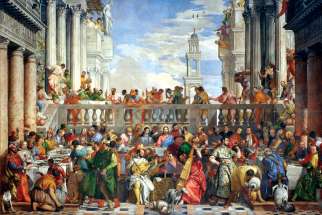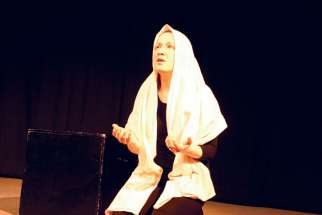God's Word on Sunday: Words of hope pave way to new reality
Second Sunday in Ordinary Time, Jan. 16 (Year C) Isaiah 62:1-5; Psalm 96; 1 Corinthians 12:4-11; John 2:1-12
Spoken words can cause great hurt and long-lasting damage.
One-woman shows bring Scripture to life
WASHINGTON – When Deacon Joseph Jensen entered Our Lady of Good Counsel Passionist Seminary in Warrenton, Missouri, in the late 1950s, he realized he was the only student in his class who had read the Bible.
Christ fills our hunger through the Scriptures
Questioning Faith
Once, a parish priest asked me and my brother if we would offer a Bible study in the nearby seniors’ home. We invited all residents to an afternoon series in their lounge. Two or three showed up regularly, but nobody else. What were we doing wrong? Why didn’t they like us?
Finally one of the attendees, who was Protestant, acknowledged to us: “They wanted to come because they like this sort of thing, but they couldn’t understand why anybody would send Catholics to do a Bible study.” This took the pressure off!
Though it cherishes a sacred book, Christianity is not a religion of the book. It’s a way, “the way,” to use one of its earliest names. It offers life through encounter with One who is the door to life. Why then does the Church have a special book (or rather, collection of books) that it considers sacred? Where did it come from, and what are we supposed to do with it?
The Church considers the Scriptures “inspired.” Perhaps this makes them seem distant, reserved for the learned few. We may want to get closer to them, without knowing the way (which, at times, is how we feel about God, too). On Oct. 18, we celebrate the feast of St. Luke, one of the four evangelists. Luke, tradition says, was a physician and knew the Mother of God. The first semester of my theological studies included a class assignment to read a Gospel from start to finish. Because the feast day was nearby, I chose Luke’s Gospel; the experience was moving and educational. I discovered somebody behind the Scripture texts. I’d always been taught God was behind them, but now I began to see and hear a human writer. Could it be that God and Luke were writing together?
What a combination — a collaboration between God and a human, in which I could join. It was like being part of a conversation and discovering that in the process, you were getting to know God. So I learned that if the Bible is inspired, that doesn’t put it far away from me, but brings it close. It’s for me, for all of us (including Catholics)!
But what does it mean to say the Bible is inspired?
The other day I saw a photograph of a nice-looking young man. A self-portrait, it showed him wearing a black, short-sleeved T-shirt and black shorts, sitting on a column like a Greek hero. His figure exuded strength and compassion. Noteworthy, but not dominant, was the lack of three limbs, though the bare scarred skin was unabashedly visible.
While on assignment in Afghanistan in 2011, photographer Giles Duley accidentally triggered an explosive device. He endured the amputation of both feet and one hand, and resumed his photography career. Differently. He explains there are things he can’t do any more, such as keep his balance while looking through a viewfinder, and some things he can do in ways he couldn’t before, such as “focus even more on the connection with people.”
Duley’s story was inspiring to me. I imagined how I might respond to similar losses, reflected on the strength of his spirit, the human capacity to transcend itself, how it often falls short but at times rises to glory. His story, his person, evoked a deep response in me.
There are degrees of inspiration. We wouldn’t say the photograph is inspired to the degree the Bible is. We hope the inspiration we get from many things will help us learn to encounter the Spirit in the Bible, where of all books He is most meetable.
The word “inspire” means to “breathe into.” For Christians, it’s a deeply laden word with profound meaning. It reminds us that God “breathed into (Adam’s) nostrils the breath of life; and man became a living being” (Genesis 2:7). It’s the truth of our humanness, that held within us like a treasure is the living Spirit of God. The Mother of God is the archetype of inspiration, so open to God’s Spirit that the Word can take flesh within her.
“Inspiration” is not a thing, but a relationship. God breathed into Adam, but Adam also started to breathe. Scripture’s authors were inspired by God, but we too, people who read, study and pray with the Scriptures, find God’s Spirit within us helping us to understand them — we, too, are inspired. That’s why the Scriptures are the books of the Church, though the Church is not a religion based on books. It’s based on a relationship between God and us.
We need this sort of inspiration in our day-to-day lives. Otherwise we get anxious, like a tiny child whose parent is out of sight. The Scriptures help bring us into the ongoing dialogue between God and humanity, in our present affliction and struggle. They’re a unique place of encounter with God. The dialogue between God and humanity becomes a person. It’s this person whom we encounter in the Scriptures, Christ who alone fills our hunger.




